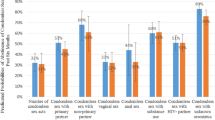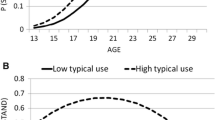Abstract
Among 14–24 year-olds who used drugs and were recruited from an emergency department, we examined 2-year trajectories of sexual risk behaviors. We hypothesized that those in higher risk trajectories would have more severe substance use, mental health concerns, and dating violence involvement at baseline. Analyses identified three behavioral trajectories. Individuals in the highest risk trajectory had a more severe profile of baseline alcohol use, marijuana use, dating violence involvement, and mental health problems. Future research will examine longitudinal differences in risk factors across trajectories. Understanding risk factors for sexual risk behavior trajectories can inform the delivery and tailoring of prevention interventions.

Similar content being viewed by others
References
Centers for Disease Control and Prevention. HIV Surveillance Report, vol. 25. 2013. http://www.cdc.gov/hiv/library/reports/surveillance/.
Center for Disease Control and Prevention. HIV Among Youth. 2015. http://www.cdc.gov/hiv/group/age/youth/index.html.
Center for Disease Control and Prevention. HIV and AIDS in the United States by Geographic Distribution. 2015. http://www.cdc.gov/hiv/statistics/basics/geographicdistribution.html.
Arnett JJ. The developmental context of substance us ein emerging adulthood. J Drug Issues. 2005;35(2):235–53.
Stone AL, Becker LG, Huber AM, Catalano RF. Review of risk and protective factors of substance use and problem use in emerging adulthood. Addict Behav. 2012;37(7):747–75.
Arnett JJ. Reckless behavior in adolescence: a developmental perspective. Dev Rev. 1992;12:339–73.
Arnett JJ. Emerging adulthood. A theory of development from the late teens through the twenties. Am Psychol. 2000;55(5):469–80.
Dariotis JK, Sonenstein FL, Gates GJ, et al. Changes in sexual risk behavior as young men transition to adulthood. Perspect Sex Reprod Health. 2008;40(4):218–25.
Substance Abuse and Mental Health Services Administration. Results from the 2010 National Survey on Drug Use and Health: summary of national findings. NSDUH Series H-41. Rockville: Substance Abuse and Mental Health Services Administration (SMA) 11-4658; 2011.
Jessor R. Problem behavior and developmental transition in adolescence. J Sch Health. 1982;52(5):295–300.
Geier CF. Adolescent cognitive control and reward processing: implications for risk taking and substance use. Horm Behav. 2013;64(2):333–42.
Mitchell MR, Potenza MN. Addictions and personality traits: impulsivity and related constructs. Curr Behav Neurosci Rep. 2014;1(1):1–12.
Voisin DR, Jenkins EJ, Takahashi L. Toward a conceptual model linking community violence exposure to HIV-related risk behaviors among adolescents: directions for research. J Adolesc Health. 2011;49(3):230–6.
DiClemente RJ, Salazar LF, Crosby RA, Rosenthal SL. Prevention and control of sexually transmitted infections among adolescents: the importance of a socio-ecological perspective–a commentary. Public Health. 2005;119(9):825–36.
Lopez LM, Bernholc A, Chen M, Tolley EE. School-based interventions for improving contraceptive use in adolescents. Cochrane Libr. 2016. doi:10.1002/14651858.CD012249.
Hallfors D, Cho H, Brodish PH, Flewelling R, Khatapoush S. Identifying high school students “at risk” for substance use and other behavioral problems: implications for prevention. Subst Use Misuse. 2006;41(1):1–15.
U.S. Department of Commerce CB, American Community Survey (ACS), 2009 and 2014. Percentage of 18- to 24-year-olds enrolled in degree-granting postsecondary institutions and percentage distribution of those enrolled, by sex, race/ethnicity, and selected racial/ethnic subgroups: 2009 and 2014. 2016.
Murphy DA, Brecht ML, Herbeck DM, Huang D. Trajectories of HIV risk behavior from age 15 to 25 in the national longitudinal survey of youth sample. J Youth Adolesc. 2009;38(9):1226–39.
Brookmeyer KA, Henrich CC. Disentangling adolescent pathways of sexual risk taking. J Prim Prev. 2009;30(6):677–96.
Huang DY, Murphy DA, Hser Y-I. Developmental trajectory of sexual risk behaviors from adolescence to young adulthood. Youth Soc. 2012;44(4):479–99.
Huang DY, Lanza HI, Murphy DA, Hser Y-I. Parallel development of risk behaviors in adolescence: potential pathways to co-occurrence. Int J Behav Dev. 2012;36(4):247–57.
Mustanski B, Byck GR, Dymnicki A, Sterrett E, Henry D, Bolland J. Trajectories of multiple adolescent health risk behaviors in a low-income African American population. Dev Psychopathol. 2013;25(4 Pt 1):1155–69.
Guo J, Chung IJ, Hill KG, Hawkins JD, Catalano RF, Abbott RD. Developmental relationships between adolescent substance use and risky sexual behavior in young adulthood. J Adolesc Health. 2002;31(4):354–62.
Centers for Disease Control and Prevention. HIV Surveillance Report, 2009; vol. 21. 2011. http://www.cdc.gov/hiv/topics/surveillance/resources/reports/.
Bohnert KM, Walton MA, Ranney M, et al. Understanding the service needs of assault-injured, drug-using youth presenting for care in an urban Emergency Department. Addict Behav. 2015;41:97–105.
Cunningham RM, Carter PM, Ranney M, et al. Violent reinjury and mortality among youth seeking emergency department care for assault-related injury: a 2-year prospective cohort study. JAMA Pediatr. 2015;169(1):63–70.
WHO Assist Working Group. The Alcohol, Smoking and Substance Involvement Screening Test (ASSIST): development, reliability and feasibility. Addiction. 2002;97(9):1183–94.
Humeniuk R, Ali R, Babor TF, et al. Validation of the Alcohol, Smoking and Substance Involvement Screening Test (ASSIST). Addiction. 2008;103(6):1039–47.
United States Department of Health and Human Services, National Institutes of Health, National Institute on Drug Abuse. Drug Abuse Treatment Outcome Study–Adolescent (DATOS-A), 1993–1995: [United States] [Computer file]. Ann Arbor, MI: Inter-university Consortium for Political and Social Research; 2008.
Bearman PS, Jones J, Udry JR. The National Longitudinal Study of Adolescent Health: research design: Carolina Population Center, University of North Carolina; 1997. http://www.cpc.unc.edu/projects/addhealth. Accessed 23 March 2005.
National Institute of Health. NIH Policy on reporting race and ethnicity data: subjects in clinical research. New York: National Institute of Health; 2011.
Smith G, Ross R, Rost K. Psychiatric outcomes module: Substance Abuse Outcomes Module (SAOM). In: Sedere LI, Dickey B, editors. Outcomes assessment in clinical practice. Baltimore: Williams & Wilkins; 1996. p. 85–8.
Smith GR, Burnam MA, Mosley CL, Hollenberg JA, Mancino M, Grimes W. Reliability and validity of the substance abuse outcomes module. Psychiatr Serv. 2006;57(10):1452–60.
Saunders JB, Aasland OG, Babor TF, De La Fuente JR, Grant M. Development of the Alcohol Use Disorders Identification Test (AUDIT):WHO collaborative project on early detection of persons with harmful alcohol consumption-II. Addiction. 1993;88:791–804.
Chung T, Colby SM, Barnett NP, Rohsenow DJ, Spirito A, Monti PM. Screening adolescents for problem drinking: performance of brief screens against DSM-IV alcohol diagnoses. J Stud Alcohol. 2000;61(4):579–87.
Darke S, Hall W, Heather N, Ward J, Wodak A. The reliability and validity of a scale to measure HIV risk-taking behaviour among intravenous drug users. AIDS. 1991;5(2):181–5.
Ward J, Darke S, Hall W. The HIV Risk-taking Behavior Scale (HRBS) manual. Randwick: National Drug and Alcohol Research Centre; 1990.
Zimmerman MA, Ramirez-Valles J, Zapert KM, Maton KI. A longitudinal study of stress-buffering effects for urban African American male adolescent problem behaviors and mental health. J Community Psychol. 2000;28(1):17–33.
Youth Risk Behavior Surveillance Survey. National High School Questionnaire. 2009. http://www.cdc.gov/HealthyYouth/yrbs/questionnaire_rationale.htm.
Mustanski B. Ethical and regulatory issues with conducting sexuality research with LGBT adolescents: a call to action for a scientifically informed approach. Arch Sex Behav. 2011;40(4):673–86.
Murphy DA, Brecht ML, Huang D, Herbeck DM. Trajectories of delinquency from age 14 to 23 in the national longitudinal survey of youth sample. Int J Adolesc Youth. 2012;17(1):47–62.
Derogatis LR, Melisaratos N. The Brief Symptom Inventory: an introductory report. Psychol Med. 1983;13(3):595–605.
Derogatis LR, Spencer MS. The Brief Symptom Inventory (BSI): administration, scoring, and procedures manual-1. Baltimore: Johns Hopkins University School of Medicine, Clinical Psychometrics Research Unit; 1982.
Sheehan DV, Lecrubier Y, Sheehan KH, et al. The Mini-International Neuropsychiatric Interview (MINI): the development and validation of a structured diagnostic psychiatric interview for DSM-IV and ICD-10. J Clin Psychiatr. 1998;59:22–33.
Sheehan DV, Sheehan KH, Shytle RD, et al. Reliability and validity of the Mini International Neuropsychiatric Interview for children and adolescents (MINI-KID). J Clin Psychiatry. 2010;71(3):313–26.
Straus MA, Hamby SL, Boney-McCoy S, Sugarman DB. The revised Conflict Tactics Scales (CTS2): development and preliminary psychometric data. J Fam Issues. 1996;17:283–316.
Rothman EF, Stuart GL, Greenbaum PE, et al. Drinking style and dating violence in a sample of urban, alcohol-using youth. J Stud Alcohol Drugs. 2011;72(4):555–66.
Swahn MH, Alemdar M, Whitaker DJ. Nonreciprocal and reciprocal dating violence and injury occurrence among urban youth. West J Emerg Med. 2010;11(3):264–8.
Testa M, Hoffman JH, Leonard KE. Female intimate partner violence perpetration: stability and predictors of mutual and nonmutual aggression across the first year of college. Aggress Behav. 2011;37(4):362–73.
Jones BL, Nagin DS, Roeder K. A SAS procedure based on mixture models for estimating developmental trajectories. Soc Methods Res. 2001;29(3):374–93.
Nylund KL, Asparouhov T, Muthén BO. Deciding on the number of classes in latent class analysis and growth mixture modeling: a Monte Carlo simulation study. Struct Equ Model. 2007;14(4):535–69.
Nagin DS, Odgers CL. Group-based trajectory modeling in clinical research. Annu Rev Clin Psychol. 2010;6:109–38.
Bonar E, Whiteside LK, Walton MA, et al. Prevalence and correlates of HIV risk among adolescents and young adults reporting drug use: data from an urban Emergency Department in the U.S. J HIV/AIDS Soc Serv. 2016;15(1):3–28.
Bishop-Townshend V. STDs: screening, therapy, and long-term implications for the adolescent patient. Int J Fertil Menopausal Stud. 1996;41(2):109–14.
Manavi K. A review on infection with Chlamydia trachomatis. Best Pract Res Clin Obstet Gynaecol. 2006;20(6):941–51.
Paavonen J. Sexually transmitted chlamydial infections and subfertility. Int Congr Ser. 2004;1266:277–86.
Tiller CM. Chlamydia during pregnancy: implications and impact on perinatal and neonatal outcomes. JOGNN. 2002;31:93–8.
Cunningham KA, Beagley KW. Male genital tract chlamydial infection: implications for pathology and infertility. Biol Reprod. 2008;79:180–9.
Howard DE, Debnam KJ, Wang MQ. Ten-year trends in physical dating violence victimization among US adolescent females. J Sch Health. 2013;83(6):389–99.
Howard DE, Debnam KJ, Wang MQ, Gilchrist B. 10-year trends in physical dating violence victimization among US adolescent males. Int Community Health Educ. 2012;32(4):283–305.
Brown LK, Tolou-Shams M, Lescano C, et al. Depressive symptoms as a predictor of sexual risk among African American adolescents and young adults. J Adolesc Health. 2006;39(3):444.e1–8.
DiClemente RJ, Wingood GM, Crosby RA, et al. A prospective study of psychological distress and sexual risk behavior among black adolescent females. Pediatrics. 2001;108(5):E85.
Coker AL. Does physical intimate partner violence affect sexual health? A systematic review. Trauma Violence Abus. 2007;8(2):149–77.
Walton MA, Chermack ST, Shope JT, et al. Effects of a brief intervention for reducing violence and alcohol misuse among adolescents: a randomized controlled trial. JAMA. 2010;304(5):527–35.
Newton AS, Dong K, Mabood N, et al. Brief emergency department interventions for youth who use alcohol and other drugs: a systematic review. Pediatr Emerg Care. 2013;29(5):673–84.
Bernstein J, Heeren T, Edward E, et al. A brief motivational interview in a pediatric emergency department, plus 10-day telephone follow-up, increases attempts to quit drinking among youth and young adults who screen positive for problematic drinking. Acad Emerg Med. 2010;17(8):890–902.
Monti PM, Barnett NP, Colby SM, et al. Motivational interviewing versus feedback only in emergency care for young adult problem drinking. Addiction. 2007;102(8):1234–43.
Acknowledgments
This study was funded by the National Institute on Drug Abuse (R01 #024646). The first author was supported by a career development award from the National Institute on Drug Abuse (K23 #036008) during her work on this project. Center support was provided by the Centers for Disease Control and Prevention (U01CE001957). The authors wish to acknowledge statistical support from Ms. Linping Duan, FYI study staff, and the patients and staff at the Hurley Medical Center.
Funding
This study was funded by the National Institute on Drug Abuse (R01 #024646).
Author information
Authors and Affiliations
Corresponding author
Ethics declarations
Conflict of Interest
The authors declare that they have no conflict of interest.
Ethical Approval
All procedures performed in studies involving human participants were in accordance with the ethical standards of the institutional and/or national research committee and with the 1964 Helsinki declaration and its later amendments or comparable ethical standards. This article does not contain any studies with animals performed by any of the authors.
Informed Consent
All adult participants provided informed consent. All minor participants provided assent while their parents/guardians provided informed consent.
Rights and permissions
About this article
Cite this article
Bonar, E.E., Walton, M.A., Epstein-Ngo, Q.M. et al. Two-Year Trajectories of Sexual Risk Behaviors Among Drug-Using Adolescents and Emerging Adults in an Urban Community. AIDS Behav 21, 2069–2078 (2017). https://doi.org/10.1007/s10461-016-1570-z
Published:
Issue Date:
DOI: https://doi.org/10.1007/s10461-016-1570-z




